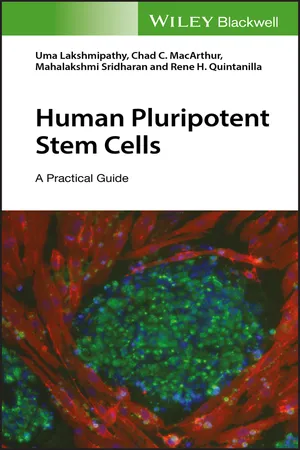
Human Pluripotent Stem Cells
A Practical Guide
Uma Lakshmipathy, Chad C. MacArthur, Mahalakshmi Sridharan, Rene H. Quintanilla
- English
- ePUB (mobile friendly)
- Available on iOS & Android
Human Pluripotent Stem Cells
A Practical Guide
Uma Lakshmipathy, Chad C. MacArthur, Mahalakshmi Sridharan, Rene H. Quintanilla
About This Book
Comprehensive coverage of the entire induced pluripotent stem cell basic work flow
Pluripotent stem cells (PSC) can divide indefinitely, self-renew, and can differentiate to functionally reconstitute almost any cell in the normal developmental pathway, given the right conditions. This comprehensive book, which was developed from a training course, covers all of the PSCs (embryonic, embryonic germ, and embryonic carcinoma) and their functions. It demonstrates the feeder-dependent and feeder-free culture of hESC and hiPSC, which will be referred to in all protocols as PSCs. It also addresses the methods commonly used to determine pluripotency, as defined by self-renewal marker expression and differentiation potential.
Human Pluripotent Stem Cells: A Practical Guide offers in-depth chapter coverage of introduction to stem cell, PSC culture, reprogramming, differentiation, PSC characterization, and more. It also includes four appendixes containing information on reagents, medias, and solutions; common antibodies; consumable and equipment; and logs and forms.
- Includes helpful tips and tricks that are normally omitted from regular research papers
- Features useful images to support the technical aspects and results visually as well as diagrammatic illustrations
- Presents specific sections (ie: reprogramming, differentiation) in a concise and easily digestible manner
- Written by experts with extensive experience in stem cell technologies
Human Pluripotent Stem Cells: A Practical Guide is an ideal text for stem cell researchers, including principal investigators, and others in university and industry settings, and for new graduate students in PSC labs.
Frequently asked questions
Information
1
Introduction
1.1 Biosafety
1.2 Biosafety Levels
- Biosafety Level 1 (BSL‐1): the basic level of protection common to most research and clinical laboratories. Appropriate for agents that are not known to consistently cause disease in normal, healthy human adults (examples: Bacillus subtilis, E. coli).
- Biosafety Level 2 (BSL‐2): appropriate for moderate‐risk agents known to cause human disease of varying severity by ingestion or through percutaneous or mucous membrane exposure. Most cell culture labs should be at least BSL‐2, and all stem cell labs have this as a requirement.
- Biosafety Level 3 (BSL‐3): BSL‐3 is appropriate for indigenous or exotic agents with a known potential for aerosol transmission, and for agents that may cause serious and potentially lethal infections.
- Biosafety Level 4 (BSL‐4): BSL‐4 is appropriate for exotic agents that pose a high individual risk of life‐threatening disease by infectious aerosols and for which no treatment is available. These agents are restricted to high‐containment laboratories.
1.3 Aseptic Technique
1.3.1 Maintaining a Sterile Work Area
- The cell culture hood should be properly set up, and located in an area that is restricted to cell culture, is free from drafts from doors, windows, and other equipment, and with no through traffic.
- The work surface should be uncluttered and contain only items required for a particular procedure; it should not be used as a storage area.
- Before and after use, the work surface should be disinfected thoroughly, and the surrounding areas and equipment should be cleaned routinely.
- For routine cleaning, wipe the work surface with 70% ethanol before and during work, especially after any spillage.
- Using a Bunsen burner for flaming is not necessary or recommended in a cell culture hood.
- Leave the cell culture hood running at all times, turning it off only when it will not be used for extended periods of time.
- Practice good personal hygiene. Wash your hands before and after working with cell cultures. In addition to protecting you from hazardous materials, wearing personal protective equipment also reduces the probability of contamination from shed skin as well as dirt and dust from your clothes.
1.3.2 Aseptic Work Area
1.3.3 Cell Culture Hood
- Class I cell culture hoods offer significant levels of protection to laboratory personnel and to the environment when used with good microbiological techniques, but they do not provide cultures with protection from cont...